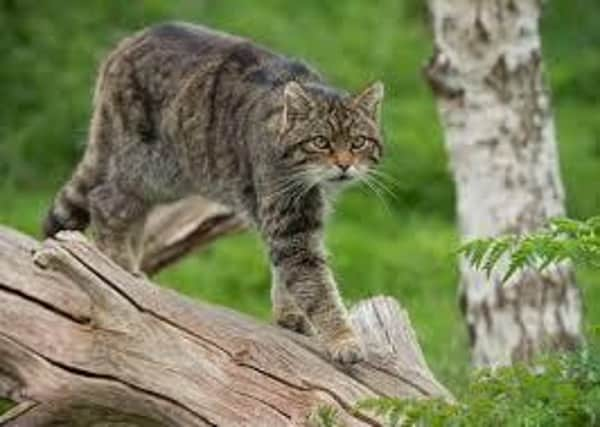Wildcat campaign group reports government agency to police over logging


The Scottish WIldcat Haven group alleged that the former Forestry Commission Scotland agency committed wildlife crimes by carrying out logging.
It says the activity at Clashindarroch forest in Aberdeenshire constitutes a “serious crime” against the endangered species which proved “particularly damaging” during breeding season.
Advertisement
Hide AdAdvertisement
Hide AdHowever, Forestry and Land Scotland (FLS), one of several new government agencies formed last year to replace Forestry Commission Scotland and Forest Enterprise Scotland, said it regarded the protection of the wildcats as being “of the highest priority,” and pointed out its forest management work was certified to international standards of best practice
A report last year by the International Union for Conservation of Nature concluded that the Scottish wildcat was on the verge of becoming genetically extinct, with as few as 30 left in isolated pockets of land in the north of the country
Those pockets include Clashindarroch, where Scottish Wildcat Haven has been engaged in a battle for several years with the government agency, accusing it of putting the animals at risk with its tree felling operations.
In a statement, Scottish WIldcat Haven said it has reported “previous and current logging” at the forest as alleged wildlife crimes, and pointed out it was illegal to disturb a Scottish wildcat den or resting place.
It said: “The recent and ongoing logging we have documented and informed you about, we believe constitutes a serious crime against the Scottish wildcat.
“The alleged illegal activities are particularly damaging as it is a crucial time in the wildcat's breeding season and the huge amount of disturbance generated by heavy machinery, chainsaws and articulated lorries can cause stressed mothers to abandon their kittens.”
The group added that its legal team has also contacted Police Scotland’s specialist wildlife crime division to inform them of the logging activity and provide supporting submissions. It has also requested a meeting with the division to discuss the issues.
It said it hoped the police recognised the “unprecedented public interest” in the matter, and pointed to a petition set up to halt logging at the forest. It has attracted more than 780,000 signatures to date.
Advertisement
Hide AdAdvertisement
Hide Ad“Like the wildcat we are fighting tooth and claw to save the Clashindarroch and like the wildcat we won’t give up,” it added.
Forestry and Land Scotland stressed that it worked to protect “one of Scotlamd’s most endangered animals.”
In a statement, it said: “The conservation and protection of Scotland’s wildcats is of the highest priority requiring a well-informed and collaborative approach to understanding their ecology to give their remaining populations the best possible chance of recovery.
“FLS’s forest management, including at Clashindarroch, is certified to international standards of best practice. Widely accepted scientific evidence recognises that sustainably managed forests involving well-planned timber production create an ideal mosaic of habitats for wildcats.
“The Scottish Wildcat Action (SWA) project, led by Scottish Natural Heritage, involves a partnership of over twenty organisations, including Scotland’s foremost conservation bodies and land management organisations.
“FLS and its predecessor Forest Enterprise Scotland has worked closely with SWA partners since October 2013 to ensure that the management of Clashindarroch, and other parts of Scotland’s forests and land, enhances their value as important habitat for wildcats.
“Wildcats have successfully co-existed with forest management activities at Clashindarroch for many years and FLS’s aim is to ensure that success continues.”
FLS added that felling work was stopped in accordance with the protocols within the guidance agreed with SWA at the end of February. Its timber extraction work continued until 15 March. All machines were off site the following day, and have been since.
Advertisement
Hide AdAdvertisement
Hide AdIt went on: “Timber haulage work has continued throughout. Log stacks can provide dens for cats so are constantly monitored with cameras. Work continues in accordance with our protocols and following best practice.”
The agency has previously stressed that it adjusts work plans at Clashindarroch if there is a risk of impacting the local wildcat population, with steps including leaving areas free during breeding season, and using camera traps and GPS tagging to track animal movements.
A spokeswoman for Police Scotland said: “We are aware of the matter and looking into it.”
A message from the Editor:
Thank you for reading this story on our website. While I have your attention, I also have an important request to make of you.
The dramatic events of 2020 are having a major impact on many of our advertisers - and consequently the revenue we receive. We are now more reliant than ever on you taking out a digital subscription to support our journalism.
Subscribe to scotsman.com and enjoy unlimited access to Scottish news and information online and on our app. Visit https://www.scotsman.com/subscriptions now to sign up.
By supporting us, we are able to support you in providing trusted, fact-checked content for this website.
Joy Yates
Editorial Director